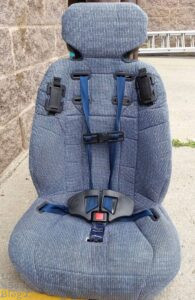What’s in a name? Confusion, mostly.

![]()
![]()
![]()
![]()
![]()
Convertible vs. Combination. Harnessed Booster vs. Booster. 3-in-1 vs. 4-in-1 vs. 5-in-1 vs. All-in-One.
Is the juvenile industry purposely messing with parents?

Ask any average parent to tell you what the difference is between a “convertible” car seat and a “combination” car seat and you will likely get a blank stare.
For what it’s worth, the term “convertible” is used to describe a carseat that can be installed either rear-facing or forward-facing. Typically, a convertible can be used for a newborn but more often it is the 2nd car seat that a child rides in, after the infant car seat is outgrown. A convertible has higher rear-facing weight and height limits so older babies and toddlers can continue to ride in the rear-facing position longer. Some convertible car seats can accommodate a child in the rear-facing position for a long time.

A “combination” seat is a forward-facing carseat with a 5-point harness that can also be used as a belt-positioning booster using the vehicle seatbelt. These seats are generally most appropriate for the preschool to school-age crowd who have outgrown their rear-facing car seats.

The term convertible was coined a long time ago since these types of products have been available since the early 1980’s and maybe even before then. It makes sense that if you designed a product that converted from RF to FF, you might decide to call it a convertible. That’s logical and not terribly difficult to remember.
 Fast-forward about 15 years to the mid-90s, when we start to see the appearance of a new type of child restraint product. One that combines the functions of a forward-facing carseat with a belt-positioning booster. I understand that the initial thought may have been, “Hey, let’s call this thing a “combination seat”, cuz… you know”. But everyone else in the room should have shot down that idea immediately. “Nooooo!!”, they should have all shouted in unison. “TERRIBLE idea. Too easy to confuse with convertible. Let’s call it a supercalifragilisticexpialidocious seat instead because then parents and consumers won’t confuse it so easily with that other type of carseat.”
Fast-forward about 15 years to the mid-90s, when we start to see the appearance of a new type of child restraint product. One that combines the functions of a forward-facing carseat with a belt-positioning booster. I understand that the initial thought may have been, “Hey, let’s call this thing a “combination seat”, cuz… you know”. But everyone else in the room should have shot down that idea immediately. “Nooooo!!”, they should have all shouted in unison. “TERRIBLE idea. Too easy to confuse with convertible. Let’s call it a supercalifragilisticexpialidocious seat instead because then parents and consumers won’t confuse it so easily with that other type of carseat.”
Obviously, that’s not what happened because here we are almost 30 years later and guess what? Parents and consumers (and even some CPS Technicians) are soooo confused. And it’s really not their fault! The words combination and convertible are so ridiculously similar that it’s almost impossible for the average parent who doesn’t live, breathe and sleep car seats to remember the differences.
I did some digging and it appears that the terms that we frequently use to describe products that have different functions and installation options are not defined anywhere in U.S. Federal Motor Vehicle Safety Standards (FMVSS) 213. These terms are defined in the CPS Technician Certification Curriculum but at the end of the day, there are no federal standards for what does and doesn’t constitute a convertible or a combination carseat . Or even what does and doesn’t constitute an All-in-One or 3-in-1 carseat.
To make matters even worse, some marketing departments have used terms that are purposely deceiving. Like a 3-in-1 seat that can’t be used rear-facing. A 5-in-1 seat that doesn’t even convert to a backless booster. A booster seat that doesn’t boost. I could go on but you get the point.
These misleading terms and practices do an immense disservice to parents because let’s face it, this car seat stuff is hard enough without purposely misleading consumers in the hopes that they buy your product over something else.
To their credit, some manufacturers have tried to cut down on the confusion by using different terminology like 2-in-1 convertible, 2-in-1 booster, harnessed booster, harness + booster, harness-2-booster and even toddler booster. But those terms still don’t really convey or clarify what these products do and don’t do.
There has to be a better way.
I’ve been mulling this over for years and have some opinions on the subject. However, I also want to hear your thoughts and suggestions on how we can better categorize these different types of products so parents understand what they’re actually buying.
Should we lobby for a system of “groups”, which is what they use in Europe? The latest European car seat standard, R129/i-Size, classifies seats based on their allowable height ranges since they’ve come to the conclusion that height is a better indicator than weight. It’s an interesting concept and you can learn more about i-Size groups here but I’m not sure if that’s the simplest way to go for parents here in the U.S.
Personally, I want to advocate for a simpler system – one that groups or classifies seats by their function(s) and orientation. This way parents know how the seat can and can’t be used. Ditch the 0+ group that they use in Europe because that’s not intuitive. Most parents in North America do not think of a newborn baby as “stage zero”.
In a nutshell, here is what I propose:
Rear-Facing = Stage 1
Forward-Facing with Harness = Stage 2
Highback Belt-Positioning Booster = Stage 3
Backless Booster = Stage 4
Classifying car seat stages in ascending numerical order is intuitive. Everyone understands that stage 1 comes first, followed by stage 2 and then stage 3.
Using this system, any rear-facing-only seat (aka, infant carseat), regardless of its weight/height limits, would be a Stage 1 seat. A convertible seat like the Graco Contender would be a Stage 1/2. The Britax One4Life would be 1/2/3. The Evenflo EveryKid would be 1/2/3/4. The Chicco MyFit would be 2/3 but the Graco Nautilus would be 2/3/4. You get the idea.
It wouldn’t be a perfect system because nothing ever is. This system wouldn’t prevent parents from intentionally buying a stage 2/3 seat after their child outgrows the stage 1 infant seat. Although far from ideal, some consumers do this already. However, if we could prevent parents from unintentionally buying a seat that was inappropriate for their child’s age and stage, that would be a huge win.
There would also be the issue of what to do with atypical products like vests and side-facing car beds where it might be challenging or impossible to group those products into these typical categories. There are also a few convertible seats that can’t be used for a newborn since the starting weight limit is 12 or 14 lbs. But those seats are anomalies in the marketplace and at least the consumer would know that the seat can be used both RF & FF, even if it isn’t suitable for a newborn.
At the very least this type of a classification system would keep a less-than-scrupulous marketing team from advertising a 4-in-1 rear-facing-only infant seat. Because you know… it’s only a matter of time.
</rant>







